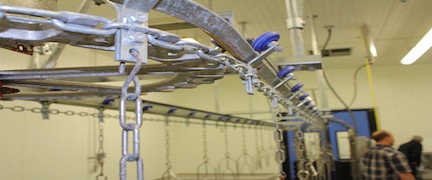Software for Inventory & Traceability Tracking for Meat Processors
The following is a re-print from NMPAN June 2016 newsletter and was written by Stan Ward, Principal Consultant, Stan Ward Consulting, specializing in Food Information Systems.
Meat processors and their livestock producer clients often ask about effective software solutions for inventory management and traceability tracking. There are many, many inventory management systems available, but the list gets much shorter for those that are suitable for very small and small meat processors. This article is intended to give an overview of the features to be considered and some specific software solutions for meat processors.
Must-Have Features
Must-have features in software solutions for all meat processors are basic inventory management and traceability tracking. Inventory management includes a set of business processes that include receiving, production, and sales, and traceability is the identification of individual, real-life items using a "lot number" or "batch number" that stays with each food item as it goes through the inventory management and manufacturing processes.
Basic inventory management and traceability for meat processors must include record keeping for:
- Receiving of products. For meat processors, "products" will include animals, primal cuts, spices, and more.
Traceability for receiving: Every item received should have a lot number/batch number recorded. If a lot number has not been assigned by the supplier or original producer, then you must assign a lot number to the item.
- Production. For meat processors, this can include disassembly of carcasses into cuts and ground, and the assembly of items using a "bill of materials" to produce things like sausage, cured meats, bacon, corned beef, and jerky.
Traceability for production: A lot number should be assigned to all final product and "work-in-progress" items produced/manufactured, as well as all ingredients which go into final product and "work-in-progress" item.
- Sales of your all of final products should be recorded.
Traceability for sales: The identity of your customers and the lot number of every item sold to your customers should be recorded.
- Recall. Utilizing the lot tracking used throughout the use of the system, recall features should easily create a report that traces the supplier, inventory in-stock, products manufactured, and customers for any ingredient or final product. Using recall features is important for actual recall events, as well as performing mock recalls and verification of traceability for third audits required by customers and certifications (e.g., organic certification).

Additional Features To Consider
Catch-weight - A must-have feature for many meat processors. Catch weight is the actual weight of a food item, originating from the seafood industry, for example, as the name implies, the actual weight of an individual fish, crab, or bag of clams. For meat processors, examples of catch weight refer to the actual weight of an individual cut, carcass, sausage, or package.
Scale integration, barcode scanning, label making - Many meat processors would optimally like to have scale integration and label making built-into their software solution, so that the can seamlessly weight, label, and put items into inventory all at the same time. For some businesses, barcode scanning can provide labor savings and decrease human errors created by manual entry of codes.
Specific software solutions for meat processors
ACCTivate is an inventory system with lot tracking, partial catch-weight support, and barcoding scanning, but it does not have scale integration. ACCTivate can provide inventory tracking on a piece level and do the sale calculation by weight. Where it does not work is tracking both pieces and weight for inventory tracking and reporting. The catch weight is only on sales. You can manually add weights for each piece, but it is just not integrated with a digital scale.
ACCTivate is a Microsoft Windows, client/server software system that integrates with QuickBooks' desktop versions. You need to install it on your own computer, and you would want that to be a server computer on your LAN for a multi-user environment. Instead of maintaining your own server, you could have it hosted by a third party hosting service, for an additional fee.
DEAR Inventory is an easy to implement, cloud-based inventory management system best suited for uniform weight final products, for example, a 12 ounce packaged beef jerky. DEAR has good lot tracking and strong food safety recall features, barcode scanning, and label printing, and it will automatically generate recall customer letters. DEAR does not support catch-weights or scale integration.
DEAR integrates with many cloud-based systems including cloud-based accounting systems QuickBooks Online and XERO, eCommerce solutions Shopify, Amazon, Bigcommerce, WooCommerce, Magento, eBay, Neto, and Etsy, the shipping logistics system ShipStation (FedEx, UPS, USPS, DHL), and Point of Sale and Payment Processors including PayPal, Vend, Stripe, and Square. DEAR also includes integration with MS-Office Word for those wishing to customize reports and forms. [Full Disclosure: After helping food business implement DEAR Inventory for three years, Stan Ward Consulting and DEAR Inventory are formalizing a partnership to enable several hours of free consulting when Stan Ward Consulting is named as account manager.]
VistaTrac is an excellent choice for small and mid-sized meat processing businesses, offering an industrial system that is located right on the production floor. VistaTrac has all of the features needed by a meat processor, including barcode scanning, scale integration, label printing, lot tracking, and recall features.
VistaTrac is a Microsoft Windows, client/server software system that integrates with QuickBooks' desktop versions and Sage, as well as SAP, Oracle, and other accounting systems offering third party integration. VistaTrac has recently changed their technology set-up to use iPads as terminals, which has made the overall cost of their solution more affordable.
Other software solutions to consider:
For more information, contact Stan Ward at stan@stanward.com.
Editor’s note: The NC Choices Technical Assistance Training Manual also has a chapter on inventory management. You can access that manual here.
